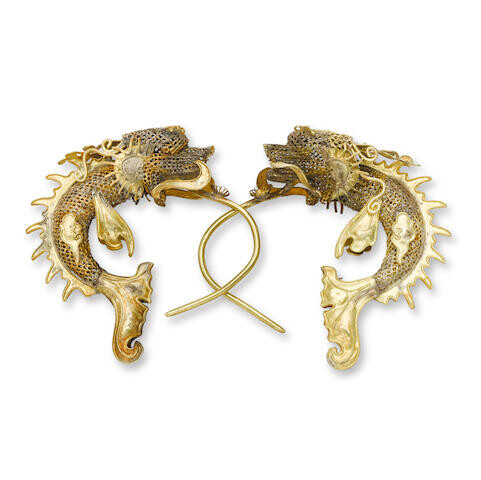A pair of gold 'dragon-fish' earrings, erhuan
Qing dynasty
Qing dynasty
Each hollowed dragon fish carefully rendered in pierced openwork and spiraling wire, the fins and tails in repoussé work, with an open mouth, spiky back, its lower chin suspending a curving wire and topped with a tiny lobed tray probably meant to hold a pearl.
1 5/8in (4.1cm) wide (2).
清 纍絲魚化龍金耳環一對
The Chinese word for fish 'yu' is identical in pronunciation to that of abundance, making the image a rebus for wealth. The design of the earrings is based on the Chinese interpretation of the sign Capricorn (mojie) itself derived from the Hindu makara (sea dragon) and absorbed into the Chinese repertory through the influence of the invading Hunnish tribes of Xiongnu, one of the ancestral tribes of the later Liao Dynasty.
Earrings in dragon-fish form appeared in many varieties during the Qing dynasty. Qing examples can be distinguished from the earlier periods by virtue of their spiky back, openwork body and the decorative clouds.
Compare dragon-fish earrings illustrated in Chinese Gold Ornaments, Simon Kwan and Sun Ji (Hong Kong: Muwen Tang Fine Art Publication Ltd., 2003), p. 551, pl. 386, and from the Betty Lo and Kenneth Chu Collection, illustrated in Adornment for Eternity (Denver Art Museum, 1994), White J.M and Bunker E.C., P. 158, pl.71.
View it on
Estimate
Time, Location
Auction House
Qing dynasty
Qing dynasty
Each hollowed dragon fish carefully rendered in pierced openwork and spiraling wire, the fins and tails in repoussé work, with an open mouth, spiky back, its lower chin suspending a curving wire and topped with a tiny lobed tray probably meant to hold a pearl.
1 5/8in (4.1cm) wide (2).
清 纍絲魚化龍金耳環一對
The Chinese word for fish 'yu' is identical in pronunciation to that of abundance, making the image a rebus for wealth. The design of the earrings is based on the Chinese interpretation of the sign Capricorn (mojie) itself derived from the Hindu makara (sea dragon) and absorbed into the Chinese repertory through the influence of the invading Hunnish tribes of Xiongnu, one of the ancestral tribes of the later Liao Dynasty.
Earrings in dragon-fish form appeared in many varieties during the Qing dynasty. Qing examples can be distinguished from the earlier periods by virtue of their spiky back, openwork body and the decorative clouds.
Compare dragon-fish earrings illustrated in Chinese Gold Ornaments, Simon Kwan and Sun Ji (Hong Kong: Muwen Tang Fine Art Publication Ltd., 2003), p. 551, pl. 386, and from the Betty Lo and Kenneth Chu Collection, illustrated in Adornment for Eternity (Denver Art Museum, 1994), White J.M and Bunker E.C., P. 158, pl.71.



